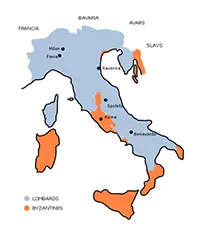The Lombards
The Lombards were a Germanic people who were part of the seemingly never-ending story of migrations across Europe in the first millennium. They migrated from southern Scandinavia through northern Europe, down through what is now Austria, and ended up in what is now northern Italy. They ruled most of Italy for two centuries, giving way to Charlemagne. 
Some sources refer to the Lombards as Langobards, meaning "long beards," a reference to their physical appearance. They were known to be in northwest Germany in the 1st Century, as part of a confederation of tribes known as the Suebi. The Lombards lived a relatively peaceful life for much of their early history in Europe. Then, in the 4th Century, they embarked on a great southern migration. They had come into contact with Rome and its neighbors before, but conflicts had been rare. By the end of the 5th Century, as Rome was falling, the Lombards were living north of the Danube River. 
In the mid-6th Century, the Lombards, under a leader named Audoin, went to war with the neighboring Gepids. The war lasted two decades and ended with a Lombard victory in 567. To cement the victory, Alboin, Audoin's successor, married the daughter of the Gepid king, Cunimund, who had been killed in the final battle. By this time, the resurgent Byzantine Empire, under the emperor Justinian's general Belisarius, had been at war in Italy with the Ostrogoths for a considerable period of time. It was the Ostrogoths who had moved into Italy after Rome fell and had established their own version of a centrally located kingdom. The Byzantines (allied with Lombards for a time) were victorious over the Ostrogoths, defeating Totila at the Battle of Taginae in 552, but did not expel the vanquished. When the Ostrogoths rose up again in 568, the Lombards had arrived for their own conquest of Italy. They had no trouble taking over a large swathe of previously Roman territory, including Benevento, Milan, Tuscany, and Venice. They took Pavia in 572 and made it their capital. In just a short period of time, the Lombards had made great gains in territorial acquisition. It was not to last, however. Alboin died suddenly, possibly at the hands of a murderer. His successor, Cleph, kept control for only 18 months. Stung, the Lombards refused to make anyone else king, preferring to have military commanders, who called themselves dukes, take command of the various cities under Lombard control. A joint Byzantine-Frank invasion in 584 convinced the Lombards to make a plea for unity by restoring the kingship, with Cleph's son Authari on the throne. Six years later, another king, Agilulf, went to war with the Byzantines and the Franks and conquered most of Italy. After a dozen years of the tyrant Aripert II, the Lombards enjoyed the peace and prosperity brought by the dynamic Liutprand, whom many historians consider the Lombards' greatest ruler. This king flexed his people's muscles and regained much of the territory lost by some of his predecessors. He ruled for more than 30 years. Midway through his reign, he forged an alliance with the Frankish king Charles Martel, including adopting that king's son Pepin the Short. Liutprand and a Lombard army marched with Martel and the Franks over the Alps in 736 to battle against encroaching Moors. Liutprand also seized control of Rome for a time. The last two rulers of the Lombards as independent people were Aistulf and Desiderius. They both attempted to expand at the expense of the pope, who turned to the Frankish king Charlemagne for assistance. The Franks, who had been in and out of the area for decades before that time, invaded again. It took them a year to conquer Pavia and with it, the Kingdom of Lombardy. Charlemagne added "King of the Lombards" to his list of titles. The duchies of Benevento and Salerno survived this occupation and flourished for another few centuries. |
|
Social Studies for Kids
copyright 2002–2024
David White




